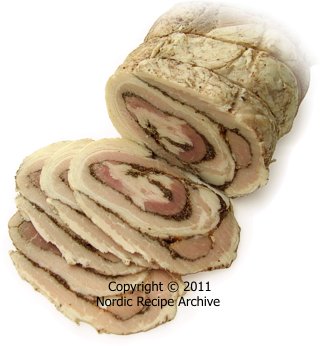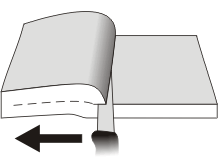
|
|||||||||||||||||||||||
| MAIN RECIPE PAGE |
|
||||||||||||||||||||||
|
RULLEPØLSE Danish spiced meat roll
Instead of pork, rullepølse can be made using lamb, veal or beef. It may also be lightly smoked. As rullepølse is first salted in brine for a day and then, after cooking, pressed for another day, it takes almost three days to prepare it. about 500 g piece of fresh (unsalted, unsmoked) pork belly, loin, shoulder or flank (not too fatty)spice mixture: 1 medium onionbrine: watercooking stock: water Prepare the brine by bringing water, salt and sugar to the boil in a large saucepan. Use 150 grams of sea salt and 20 grams of sugar for every 1 litre of water. Cool the brine by placing the pan in a cold water bath. Place the piece of meat flat against a cutting board/work surface and trim off some of the excess fat, leaving some on however, as otherwise the roll will be too dry. Using a long, sharp knife, start slicing the meat horizontally at the height of about 1 centimetre up from the cutting board, see figure 1 below. Make sure to cut along the grain and not against it — the meat will be rolled up along the grain, so that the finished roll will be cut crosswise, across the grain. Cut towards the opposite side, yet do not cut through, but leave the upper and lower slice attached at the side. Fold out the upper part, "opening" it like a page of a book, see figures 2 and 3 below.
Continue slicing the meat from the middle towards the edge, again leaving about 1 centimetre thick layer of meat on the bottom side, see figure 4 below. Fold the new cut part open like the first one, see figure 5 below.
Depending on the thickness of your meat piece, continue to make cuts until the meat forms a rectangle with an even thickness throughout, see figure 6 below.
Starting from the shorter side, roll up the meat like a jelly roll, to check if it forms an even shape. If the roll is uneven, unroll it and trim strips of meat from the thicker parts, placing them over any thinner parts to cover them. You can also trim the ends of the roll, to make them more even. Unroll the meat and set aside while you prepare the spice mixture. Salt, black pepper, allspice, cloves and marjoram or thyme seem to be the most essential spices used in the more traditional recipes for rullepølse, so you can omit the onion and coriander (and garlic) from the above spice mixture, if you like. In addition, many recipes use gelatine (in granulated or leaf form) spread on the meat, which helps to "seal" the roll more firmly together. For the spice mixture, peel the onion and mince it extremely fine, preferably using a good-quality vegetable chopper or a food mixer. (If using garlic, push peeled cloves through a garlic press.) Combine the dry spices and mix with the minced onion (and garlic). Spread the spice mixture evenly on the meat and roll it up, forming a tight cylinder. Fasten the roll by tying it up with kitchen twine. Place the roll in a large enough glass or ceramic bowl, pan or other container and cover with the cooled-down brine. Place a plate or some other weight on top to keep the roll submerged in the brine, cover the dish and place in refrigerator overnight, for about 12 to 24 hours. Note that a shorter time may be enough to adequately salt a roll of this small a size. On the next day, prepare the spices and vegetables for the cooking stock. Peel and quarter the onion, peel the carrot and cut in large chunks. Halve the piece of leek lengthwise and rinse thoroughly. Rinse the parsley and thyme. Take the meat roll out of the brine, discard the brine and rinse the roll briefly under cold water. Place the roll in a saucepan and cover with fresh, cold water. Bring the water to the boil, skim any foam and add the stock vegetables and spices. Lower the heat and gently simmer the meat until a thin metal skewer (eg a knitting needle) inserted into the roll comes out easily, without any sticking — about 1 hour and 15 minutes should be enough for a roll of this size. If using a meat thermometer, the inner temperature of the roll should be about 65 °C at this stage. Take the pan off the heat — the inner temperature of the meat roll should further rise to about 70 °C. Let the roll cool in the brine for about half an hour at room temperature, then lift it up, tap dry and place inside a snug rectangular dish, like a small, sturdy bread pan and place another pan of suitable size on top to press the roll down (the Danes have special rullepølse presses for this purpose). Before doing this, you can place the roll inside a freezer bag, squeezing/sucking out the air and sealing the bag tightly. Place some heavy weight(s) in/on the top pan, or press it down hard against the roll and fasten the two pans together by tying a sturdy rope tightly around them. Refrigerate overnight, for about 12 to 24 hours. On the next day, take the meat roll out of the press (and the bag) and cut off the kitchen twine. Slice the roll as thinly as possible and serve as cold cut, for example on a buttered slice of black rye bread, topped with slices of pickled gherkins, beetroot and/or raw onion. The meat roll will keep for about a few days, refrigerated and wrapped in plastic. Recipe source: adapted from "Hjemmelavet rullepølse", www.dr.dk, Smag på Danmark - med Meyer, "Rullepølse", www.maduniverset.dk, www.svinegodt.dk and www.madabc.dk, accessed 2011. |
|||||||||||||||||||||||
|
 Here is one version of this traditional Danish meat roll preparation. It is served thinly sliced as cold cut on open sandwiches.
Here is one version of this traditional Danish meat roll preparation. It is served thinly sliced as cold cut on open sandwiches.





